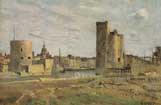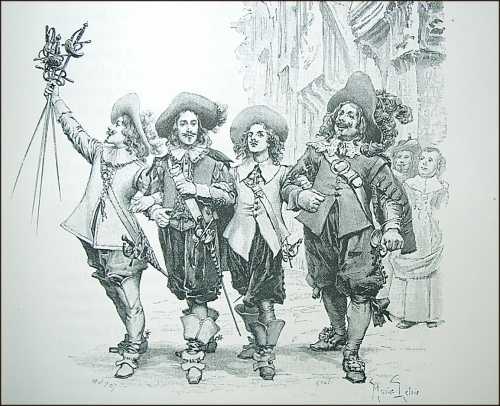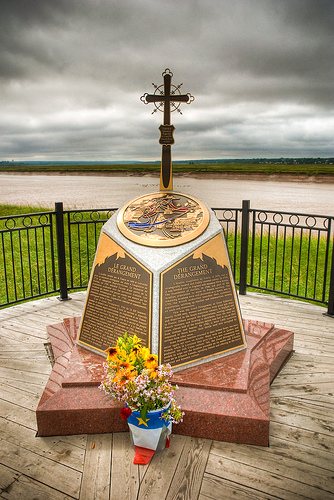
Pioneers of Acadien / Acadian Culture
The Louisiana Acadian Lineage of Pierre Mellanson, Sieur dit Laverdure
Evidence Presentation and Overview of Surname Origin History
Contents
1) Beginnings in La Rochelle, France2) So, what's the significance of fleeing the 1627 Siege of La Rochelle?
3) Migration to l'Acadie, Nova Scotia
4) Mélançon vs. Melanson
Beginnings in La Rochelle France
There is much left untold about the origins of the one of the initial pioneering and largest Acadian families:
The Mélançon / Melanson / LaVerdure family
Current traceable evidence of lineage ends with the birth of the family's French patriarch, Pierre dit La Verdure and English matriarch, Priscilla. The original surname is thought to stem from the English name: Mallinson. But, it has also been thought that the Scottish surnames: McMellan, or McMillan, could be logical candidates.
Thoughout several generations it was believed that this family may have originally originated in Scotland. With this assumption generally believed to be based on a historic mistake, the Scottish descent theory has been replaced with contradictory French and English Descent evidence, although the Scottish descent connection has proven to be difficult to abandon for some who apparently wish it to be so. However, it appears that a man by the name of Father Clarence d'Entremont more firmly established that this family is of French and English origin.
* "In the spring of 1657 in fact, he embarked on board the vessel Satisfaction in England, commanded by Captain Peter Butler. Sir Thomas Temple came to Boston to replace John Leverett commanding temporarily conquered territory. Having registered his credentials to Boston on July 16, he landed at the St. John River part of his "company" a few days later, which included Pierre Laverdure, Protestant born in France, and his wife Priscilla, English origin and nationality, as well as parents of Peter and Charles Melanson, Melanson ancestors in Acadia. From here, Temple went to install the rest of the world in Port Royal. As for himself, he preferred to live outside of Acadia, mostly in the Boston area throughout its mandate."
*source: (Petit manuel d'histoire d'Acadie - From the beginnings to 1670, La Librairie Acadienne, University of Moncton, Rev.. Clarence-J.d'Entremont, 1976)
Evidence has also been found in the form of a letter confirmed to have been written by Priscilla to the governor of Massachusetts and his council which was found in the archives of the Supreme Court for the county of Suffolk in Boston (Petition of Priscilla Laverdure, Boston, 3 May 1677, Massachusetts Archives, Suffolk County Supreme Court Files [hereafter cited as MA Suffolk], Vol. 18, p. 1592). In the letter, dated 3 May 1677, Priscilla stated: "I am an English woman widow of the said Peter (English form of the French "Pierre") Laverdure, a protestant Frenchman...".
Also, another source states:
* "In Massachusetts, the petition was filed by the widow of Pierre La Verdure, in which she identifies herself as an Englishwoman and her late husband as a French Protestant who fled from religious persecution in Nova Scotia (then l'Acadie)."
*source: (XV Congreso Internacional de las Ciencias, GENEALOGICA Y HERALDICA; Madrid, 1982; p. 535; includes Bibliography of Genealogical Research in Nova Scotia).
Still, another letter written in 1720 by John Adams, a respected New England member of the government council at Annapolis Royal has been discovered. John Adams had visited with Pierre Mellanson and stated that Pierre was:
* “an aged English Gentleman who came into this Country with Sir Thomas Temple and lived here ever since”.
* source: John Adams to the Hon. Paul Dudley, 22 Sep 1720, The Baxter Manuscripts edited by James Phinney Baxter, Collections of the Maine Historical Society, Series 2, Documentary History of the State of Maine, Vol. 9, p. 461
Based on this significant body of evidence, one can logically deduce that the Mélançon / Melanson / LaVerdure patriarchal ancestor in Acadia, Pierre dit La Verdure, was a French Huguenot who appears to have fled to England to escape French persecution after the French siege and fall of La Rochelle and the ongoing Huguenot persecution between October 1627 and the end of 1628.
The fact that Pierre dit LaVerdure fled French religious persecution by leaving La Rochelle during the period 1627-28 accounts for why, after the Treaty of Breda in 1667 he sought refuge in English controlled Boston, Massachusetts. It also more firmly establishes the English and French hypothesis:
* "Pierre MELANSON dit LAVERDURE was a French Protestant who married in exile in England to an Englishwoman named Priscilla ---. Taken with his family to Acadia by Thomas TEMPLE in spring 1657, Pierre, his wife and young son retired to Boston, MA after the treaty of Breda in 1667. Their two other sons, already married to Acadian women, remained in Acadia.".
*source: Univ. of Moncton, Centre d'etudes acadiennes, by Stephen White, on the 37 Acadian families hosting the 1994 World Congress; orig. published by La Societe historique acadienne, CAHIERS; vol. 25, no. 2&3 (Apr-Sep 1994), at
So, what's the significance of fleeing the 1627-28 Siege of La Rochelle?
In 1627, La Rochelle was the last major French Protestant Huguenot stronghold and hence, the area of greatest resistance to the religious diversity intoleration of French monarchial control. Simply put, the Huguenot revolt was one of the most significant thorns in the monarchy's side at that time.
As a result Cardinal Richelieu, chief minister to King Louis XIII, sought to extinguish the rebelling Huguenots once and for all. Richelieu laid siege to the city by blockading it for a period of 14 months. The population of La Rochelle was roughly 27,000 at onset of the siege in September 1627. Over 22,000 perished during the siege, and the population dwindled to roughly 5000 by the end of the siege in late October 1628.
The siege of La Rochelle was one of the deadliest examples of religious intolerance of that time. And horrifyingly, the mortality rate of the siege does not factor into account the perishing numbers of Huguenots that fell victim to the nation wide, and monarchy supported, Huguenot persecutions of the era.
This is one reason that the siege of La Rochelle became a central plot in Alexandre Dumas, pere's novel The Three Musketeers.

|
|
The Three Musketeers; 1894, Maurice Leloir |
||
| The Three Musketeers | ||||
Persecution of Huguenots plagued France at different times during the 15th and 16th centuries. As with the infamous European Witch Hunt persecutions, the Huguenot Persecutions peaked during the 17th century. During these persecutions, many Huguenots were captured, killed, tortured and burned at the stake. Escape from France was forbidden under strictest punishments, but many Huguenots thought it worth the risk to attempt an escape of the persecution despite the possible, and probable consequences.
Significance? It is quite possible, if not probable, that no member of the Mélançon / Melanson / LaVerdure family line would have ever existed had Pierre dit LaVerdure decided to play it safe and not risk all by fleeing French tyranical genocide at that critical point in history.
To that horrible thought, I hold dearly but one thing in mind:
le français: Merci!, Monsieur LaVerdure de votre décision courageuse et noble à comique et de combat pour votre croyance, et savoir quand courir beaucoup.
in english: Thank you, Mr. LaVerdure for your courageous and noble decision to stand up and fight for your beliefs, and knowing when to run like hell.
From Migration to England to Migration to l'Acadie

|
|
As previously stated, after fleeing to England, Pierre dit La Verdure married a woman believed to have been from Yorkshire, named Priscilla. It is thought that her surname was Mallinson. With Sir Thomas Temple, Pierre dit La Verdure traveled to Acadie in the spring of 1657 aboard the HMS Satisfaction with his wife, Priscilla, their 3 children: Pierre, Charles and Jean. Cromwell had recently, during the onset of this period of English occupation, appointed Sir Thomas Temple as the Governor of Acadia, Nova Scotia. |
||||||
After Acadia was returned to France following the treaty of Breda, in 1667, Pierre dit La Verdure, Priscilla Mallinson and their son Jean, who adopted the surname Laverdure, settled in Boston, MA. Pierre dit La Verdure's two sons, Pierre and Charles Mellanson denounced Protestantism, converted to Roman Catholicism and married Acadian women. Pierre and Charles, along with their immediate descendants lived in Novia Scotia until the Le Grand Deportation - Acadian Exile in 1755.
Charles is credited for being a founder of the Mellanson Settlement, located near the Port Royal (known today as Annapolis Royal). Pierre moved from the Port Royal area around the year 1680 and is credited with being a first founder of Grand-Pré , which is located in the Minas area near the Bay of Fundy.
These two sons appear to be the first to adopt their mother's surname, Mellanson.
Mélançon vs Melanson
It seems a majority of historical and genealogical accounts of the Acadian story tend to focus on the original homeland - Acadie, Nova Scotia. Understandably, of course, for that is where the Acadian's deep rooted and life loving heritage was birthed, and peacefully nurtured for a century or greater prior to the ethnic cleansing attempts that commenced in 1755 by the British Crown.
This is especially the case in, until now, many historical accounts of the Mélançon / Melanson / LaVerdure family line. Most of these accounts have been researched, investigated and documented by the southern Acadian's cousins who have concentrated on the branches of the family that returned home to Nova Scotia or other northern areas of the globe after having survived the Acadian holocaust, expulsion, exile and genocide, otherwise known as the Le Grand Dérangement of 1755.
When the French and Indian War (Seven Years War) came to an end, the exiled Acadians began to return to Nova Scotia or find new homes in other areas of the globe. The migration began around 1763, after they lived as exiles, deportees and prisoners for nearly a decade during Le Grand Dérangement of 1755.
The descendents of the three sons of of Pierre dit LaVerdure and Priscilla Mallinson, the different portions of the Mélançon / Melanson /LaVerdure family migrated to the following areas:
|
Mélançon Descendents of Pierre Méllanson Sieur dit LaVerdure (Grand-Pré) |
Melanson Descendents of Charles Mellanson dit LaRamée (Mellanson Settlement) |
Laverdure Descendents of Jean Mellanson dit LaVerdure | ||||||||||||
|
Accadien Coast Attakapas (Louisiana) Cherbourg (France) |
New Brunswick Annapolis (Nova Scotia) France England |
Boston Massachusetts Maryland |
Significance of the "dit LaVerdure" Surname
There are six other men with the ‘dit’ name of La Verdure associated with Acadia:
Germain Doucet dit LaVerdure
Bernard Doucet dit LaVerdure
Pierre Melanson dit LaVerdure (peré)
Pierre Melanson Sieur dit LaVerdure (fils)
Jean Melanson dit LaVerdure
François LeClerc dit LaVerdure
Claude Guédry dit LaVerdure
THE ACADIAN MELANSONS.
MELANSONS, The Acadian - Hon A. W. Savary, J. C.C., 360
The New Brunswick Magazine, vol. 1, 1898, pp. 129 et seg.
I must enter my humble but emphatic dissent from the dictum of M. Richard, (Acadia, p. 29) adopted and elaborated by Mr. Hannay in The New Brunswick Magazine, vol. 1, 1898, pp. 129 et seg., that the father of the two Melansons named in the census of Port Royal, taken in 1671, was one of Sir William Alexander's Scotch Colony who had remained in the country and joined and intermarried with the French. I submit the following considerations :
1. He was, as Mr. Hannay himself shews, the Sieur of La Verdure, a title somewhat analogous to that of Laird in Scotland, identifying him with the gentry or petite noblesse of France, or certainly a position higher than that of the ordinary peasant, artisan or soldier. His high authority as Captain Commandant of the garrison corresponded with the social rank indicated by his title. D'Aulnay would never select one of Sir William's humble Scotch followers, but rather a well educated and well bred Frenchman, as tutor and guardian of his children.
2. The Abb6 Sigogne is my authority for the assertion that Mélançon (c cedilla) was the old and correct spelling of the name, although the "s" being idem sonans is permissible.
3. Names ending in "son" by no means bear unmistakable evidence of being of British or Scandinavian origin, for there are hundreds of French names with that terminal syllable not connected either in origin or meaning with the ordinary English or Tuetonic "son" or "sen".
4. The termination referred to came into use to form a patronymic, by adding it to ordinary Christian or given names of parents: so Danielson, English, Danielsen, Danish, son of Daniel; Johnson, English, Jansen, Dutch, for son of John; Thomson, for Thomas' son; Nicholson, for Nicholas' son, and the like; but there is no similar Scotch or English name which could have been thus compounded to form Melanson.
5. I have overhauled a Directory of Scotland, and cannot find there any name which could be identified with Melanson or gallicized into that form, although it is easy to imagine the English Coulston, or the Scotch Colinson or Collison assuming among the French the form Colson, or Colleson. The nearest approach to the name Melanson that I could find in the Directory is in the Irish and Scotch Mullan, and McMullin.
As to the Martin family being Scotch, I would like further to remark that the name Martin is equally English, Irish, Scotch and French; and perhaps the same may be said of Vincent, although I think the latter name is more common in France than in the United Kingdom. The mere names in these two cases prove nothing; but it seems impossible that the immigrant ancestor of the Melansons could have been of Scottish birth.
A. W. Savary.
Copyright © 2010 - All Rights Reserved - Louisiane Acadien / Acadian Melancon
Template by OS Templates

